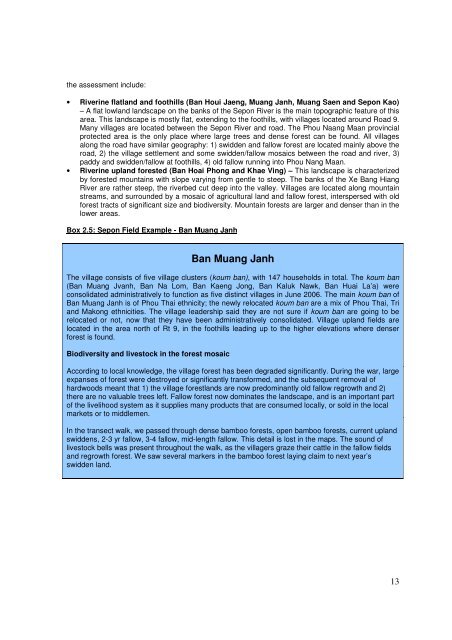Part 1 – A Rapid Participatory Biodiversity Assessment - IUCN
Part 1 – A Rapid Participatory Biodiversity Assessment - IUCN
Part 1 – A Rapid Participatory Biodiversity Assessment - IUCN
You also want an ePaper? Increase the reach of your titles
YUMPU automatically turns print PDFs into web optimized ePapers that Google loves.
the assessment include:<br />
• Riverine flatland and foothills (Ban Houi Jaeng, Muang Janh, Muang Saen and Sepon Kao)<br />
<strong>–</strong> A flat lowland landscape on the banks of the Sepon River is the main topographic feature of this<br />
area. This landscape is mostly flat, extending to the foothills, with villages located around Road 9.<br />
Many villages are located between the Sepon River and road. The Phou Naang Maan provincial<br />
protected area is the only place where large trees and dense forest can be found. All villages<br />
along the road have similar geography: 1) swidden and fallow forest are located mainly above the<br />
road, 2) the village settlement and some swidden/fallow mosaics between the road and river, 3)<br />
paddy and swidden/fallow at foothills, 4) old fallow running into Phou Nang Maan.<br />
• Riverine upland forested (Ban Hoai Phong and Khae Ving) <strong>–</strong> This landscape is characterized<br />
by forested mountains with slope varying from gentle to steep. The banks of the Xe Bang Hiang<br />
River are rather steep, the riverbed cut deep into the valley. Villages are located along mountain<br />
streams, and surrounded by a mosaic of agricultural land and fallow forest, interspersed with old<br />
forest tracts of significant size and biodiversity. Mountain forests are larger and denser than in the<br />
lower areas.<br />
Box 2.5: Sepon Field Example - Ban Muang Janh<br />
Ban Muang Janh<br />
The village consists of five village clusters (koum ban), with 147 households in total. The koum ban<br />
(Ban Muang Jvanh, Ban Na Lom, Ban Kaeng Jong, Ban Kaluk Nawk, Ban Huai La’a) were<br />
consolidated administratively to function as five distinct villages in June 2006. The main koum ban of<br />
Ban Muang Janh is of Phou Thai ethnicity; the newly relocated koum ban are a mix of Phou Thai, Tri<br />
and Makong ethnicities. The village leadership said they are not sure if koum ban are going to be<br />
relocated or not, now that they have been administratively consolidated. Village upland fields are<br />
located in the area north of Rt 9, in the foothills leading up to the higher elevations where denser<br />
forest is found.<br />
<strong>Biodiversity</strong> and livestock in the forest mosaic<br />
According to local knowledge, the village forest has been degraded significantly. During the war, large<br />
expanses of forest were destroyed or significantly transformed, and the subsequent removal of<br />
hardwoods meant that 1) the village forestlands are now predominantly old fallow regrowth and 2)<br />
there are no valuable trees left. Fallow forest now dominates the landscape, and is an important part<br />
of the livelihood system as it supplies many products that are consumed locally, or sold in the local<br />
markets or to middlemen.<br />
In the transect walk, we passed through dense bamboo forests, open bamboo forests, current upland<br />
swiddens, 2-3 yr fallow, 3-4 fallow, mid-length fallow. This detail is lost in the maps. The sound of<br />
livestock bells was present throughout the walk, as the villagers graze their cattle in the fallow fields<br />
and regrowth forest. We saw several markers in the bamboo forest laying claim to next year’s<br />
swidden land.<br />
13

















